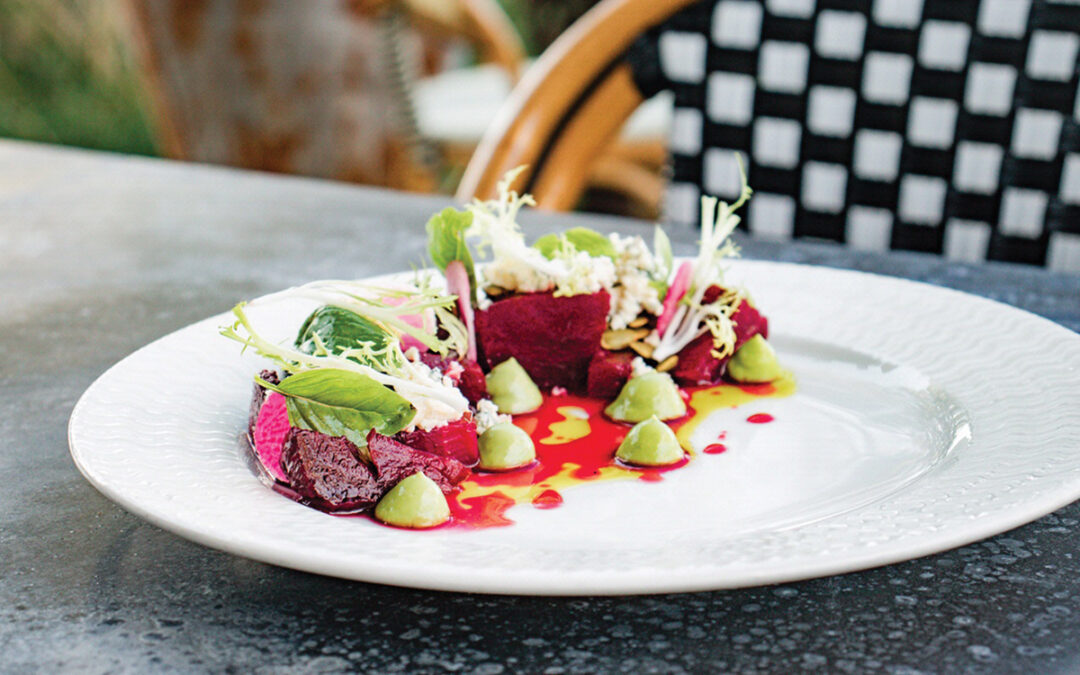Thai was not the first cuisine to begin elbowing out Chinese as our only Asian option; in San Antonio, at least, that distinction belongs to the Vietnamese — with a sideways glance at Japan. (Think returning servicemen — and often their brides.) Korean and Indian still lag, though they’re gaining ground. But the number of Thai restaurants now actively engaging our attention seems to suggest an enduring affair with Tom Yung Goong and Pad Kee Mao — no, they’re not the Thai equivalent of Bollywood stars. Many of us were first seduced by the simplicity of peanut sauce on skewers of marinated chicken, only later graduating to the subtly sophisticated soups and the complex curries of red, green and yellow. A good place to kindle a new flame, or restart an old one, is Sawasdee Thai Cuisine, where at night, your skewers of chicken or pork satay may be brought to you by servers clad in silk. Beware the sweet plum sauce on otherwise worthy appetizers such as the polite but unique Lady Shrimps deep fried in rice paper and the stuffed Bangkok Wings.
But know that yellow curry here is Asian comfort food; its blend of potato, carrots, onions and coconut milk seems especially suited to chicken or pork. And the roasted duck red curry should not be shunned just because it’s presented in a pineapple shell; if you’re up to it, ask for this one spicy, as the pineapple will help blunt the heat. (www.sawasdeesa.com).
Not far from Sawasdee is Thai Dee, a restaurant whose upfront BYOB policy has made it a favorite of wine geeks bearing bottles of riesling or gewürztraminer, two grapes that have a special affinity for spicy foods. An appropriate starter here might be the traditional shredded green papaya salad bathed in spicy lime juice and topped with chopped peanuts; yes, salads can handle some heat. You may need to convince your unfailingly courteous server to ratchet up the spice level on some dishes — assuming you’ve convinced yourself. But the request will pay dividends with plates such as the green curry noodles with eggplant, basil, peppers and coconut milk (your choice of protein). Angry Ocean, a stir-fried seafood combination, suggests spice, not attitude; added heat makes even tilapia taste good in a dish of ginger fish with sautéed ginger, crushed garlic, mushrooms and peppers. (www.thaideesa.com). Thai Chili, now in two locations, has been around since 2000, making it more or less middle-aged in the spectrum of local Thai restaurants. Most often at Asian restaurants, the identity of the chef isn’t even known, never mind prominent. But the garrulous Chai Ngamsomjam has made a name for both himself and his cuisine, first on Thousand Oaks (now in new quarters) and later at Stone Oak and Huebner.
We will start by counseling care when approaching the lunch buffet at the Stone Oak outlet; it has disappointed in the past. But we think that the Thai beef jerky, deep fried and topped with cilantro and jalapeños, should be tried. The traditional tod mun pla, fried fish cakes served with red onion, cucumbers, peanuts and more jalapeños, are another good appetizer possibility. But though the Thai chicken wings, marinated in soy, garlic and white pepper, are meaty and generous, we’re not quite sure how they’re meant to be eaten; the serving of lettuce suggests a wrap, the bones in the wings imply otherwise. But regardless of small setbacks, we always come back to the supremely satisfying “old-style” pumpkin curry. A level six out of 10 is just hot enough, leading to a nine out of 10 overall evaluation. (www.thaichili.net).
So far, we’ve been touting taking a little heat in most Thai dishes. Bangkok 54, on the other hand, comes with a fire-alarm warning: The heat index here ranges from 0-6, with the highest being listed as 911. We find level four to be personally challenging enough but feel duty-bound to order dishes “Thai-hot” regardless. Most rational people would find level three, or “American hot,” more than adequately incendiary. And a dish such as soft shell crab with basil (it sounds deceptively simple) doesn’t need a lot of added heat to shine, in any case. Though it’s a visual train wreck of sorts, this layering of soft shell crab with fried eggplant in a boisterously chunky sauce is unexpectedly archaeological — one just keeps uncovering new things. Less demanding, but equally satisfying, is 54’s mussaman curry with more of those ubiquitous potatoes and peanuts; a dish of drunken noodles is nonetheless rewarding for being vegetarian. The tongue can be given a rest at the front end of your experience with the mellow kanom jeep steamed dumplings in brown butter sauce, or at meal’s end with the unusual dessert that is taro custard with sweet rice in coconut cream. Both reflect 54’s slightly different take on Thai as well as its more-sophisticated-than-most décor. (www.bangkok54restaurant.com/sanantonio).
Oddly, for a city that has no Asian neighborhood, three of the city’s best Thai restaurants are to be found on the I-35 corridor east of town. Thai Spice, located in The Forum, may have been the first, and it has been typical of Asian restaurants in many ways — family members (mostly women in this case) immigrate to the kitchens of established restaurants, keeping the cuisine at once fresh and grounded in home-country tradition. We aren’t especially fond of the fried spring rolls here — or much of anywhere else, for that matter— but find TS’s take on the equally ubiquitous pad Thai (it’s wrapped in a sheet of fried egg) to be a breath of fresh air. The obligatory fish cakes, which can be rubbery in the wrong hands, are masterful too, with the accompanying condiments giving them an additional boost. We haven’t had the Tiger Cried lately, but as this traditional dish of sliced seared beef is served “with a madly hot sauce on the side,” it will be hard to resist next time. We’re also eager to revisit the Panang curry, traditionally made with beef — and classically milder than many. It’s not all about the heat, though if you have indulged, purple rice pudding will help tame the tingle at meal’s end. (No direct website that I could find).
As do many proprietors of Asian restaurants, Bangkok Cuisine’s chef/owner Varaluck Kaowsan, grows her own Thai basil, lemon grass, Thai chilies and more, and the freshness is especially apparent in the dining room. For that reason, if tom kha gai, the famous chicken soup with coconut milk, kaffir lime leaves, galangal and a host of other herbs and spices, is still on your bucket list, have it here and be done with it. True, on a recent visit we weren’t thrilled with the cucumber salad, another dish that thrives on freshness, and attribute our indifference to a sweet and sour sauce that emphasized the latter. But we were ecstatic over two eggplant dishes. The (relatively) more mellow of the two consisted of slender purple eggplant stir fried with chicken, salted soybeans (keep looking; you’ll find them), basil and serrano peppers, and it was addictive. A dish of bracing green curry with pork, golf ball-sized green eggplant (surprisingly crunchy), basil and coconut milk kept us going back for more despite a challenging level of heat — one we had only ourselves to blame for. Ambiance may not be Bangkok’s strong suit, though the pale green walls of yore are gone, but service and attention to detail more than compensate. (Facebook.com/Bangkok Cuisine).
Siam Cuisine, a restaurant we wish were nearer to us, is unique in many ways: They supply a helpful glossary of Thai terms (moo, despite what you might automatically think, means pork); and though you might need to round up a posse to experience them properly, there are three set menus emphasizing Thailand’s regional cuisines — northern, Bangkok (central) and southern. The diligent diner can suss out some of these specialties on his or her own, the especially good green papaya salad, from the north, being one of them. Other dishes worth exploring include the gaeng massaman, which is said to betray a Middle Eastern influence with its incorporation of cinnamon, cloves, nutmeg and cumin into the traditional pantheon of tamarind, coconut milk, peanuts, and potatoes.
Deep-fried chicken wings stuffed with ground pork and crystal noodles are worth a look-see, too, as is the northern fried rice with house-made fermented Thai sausage, eggs, and onions. We also suggest the houy tod, battered and deep-fried mussels (huoy is defined simply as shellfish) with bean sprouts, green onion and egg; they’re as unique as the unusually pleasant interior in beige and bamboo tones. All that culinary heat sometimes wants a serene environment as a backdrop.









0 Comments